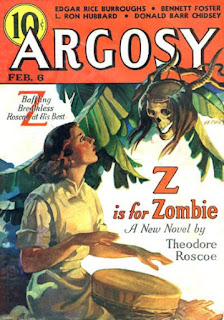Rafferty Valois is an American newspaperman. Or rather, an ex-newspaperman. He’s somewhere on the Riviera. He doesn’t know how he got there. He’s also not sure where Loretta came from. Loretta is the girl he’s with.
Something strange is happening to Rafferty. People are treating him as if he’s famous. Even before he was fired he wasn’t the least bit famous.
He is informed that the Countess Becellini wants to see him immediately. He isn’t interested, until he finds himself given a thousand dollars as a retainer. He has never seen so much money before. He has no idea why the Countess wants to employ him but for a thousand dollars he doesn’t care. There are very few things he wouldn’t do for a thousand bucks.
The Countess wants his services in a rather delicate matter. There are some letters which have fallen into the wrong hands. She wants Rafferty to get them back for her. She chose him for the job because she knows he has so much experience in matters of international intrigue. That puzzles Rafferty because he has no experience at all in such matters.
Rafferty soon realises that he is mixed up in a very complicated intrigue. It involves the Countess, her headstrong daughter Bianca, a sleazy Italian prince, a callow but mysterious young American and a gangster. It all seems to be something to do with Bianca’s upcoming marriage to the King of Movania.
That’s not as big a deal as it stands. King Michel has never actually been king. His father was deposed years earlier. And Movania is a small insignificant country. King Michel has been raised in America. There are rumours of a conspiracy to restore the monarchy in Movania but rumours about coups in tiny tinpot countries are commonplace enough. The marriage is however very important to Countess Becellini. It is her chance to restore her social position. It seems that somebody doesn’t want this marriage to go ahead.
Countess Becellini is not the only person who wants to employ Rafferty. Lots of people want the services of the famous and daring adventurer. Rafferty still can’t figure out where this reputation of his comes from.
Rafferty is a nice enough guy. He’s willing to work for anybody if they’re willing to pay him large amounts of money but he certainly has no intention of getting involved in anything illegal or anything nasty like murder. So when one of the people mixed up in this complicated affair does get murdered he’s not very happy about it.
Rafferty’s weakness is that he’s always getting persuaded to help out damsels in distress and when such a damsel needs to be rescued he just can’t say no.
This is not a straightforward spy thriller but it certainly involves international intrigue so it can be considered to fall into the genre of spy thrillers. It’s definitely not in the style of the new breed of spy thrillers that emerged in the 1950s with the success of Ian Fleming’s Bond novels. It has more of the feel the feel of a 1940s spy thriller like Victor Canning’s Panther’s Moon. Although written in 1951 the basic story actually seems in some ways more like something out of the 1920s or 30s. The plot is reminiscent of thrillers of that period such as Dornford Yates’ Blood Royal.
I happen to like that older style of thriller so I don’t mind the slightly old-fashioned feel.
There’s not much action (although there's a decent action finale). It’s not an action spy thriller. There is however mystery and suspense.
There are also plenty of sexual dramas. Rafferty likes women. He likes them a lot. There are suggestions that some of the characters have dark sexual secrets to hide. It’s also pretty clear that Loretta is a whore. She is however a really nice girl. While the book is old-fashioned in some ways its honest and open approach to sex is more in tune with the newer style of spy thriller that would shortly start to emerge.
The plot has some satisfying twists. The ending is not quite what I expected. Or at least Rafferty’s actions at the end are slightly unexpected. But the ending works extremely well.
And there is a cheetah. Her name is Iris and she will play an important part in the story at one point.
The Lady and the Cheetah is a thoroughly enjoyable thriller. It’s highly recommended.
Stark House have reprinted The Lady and the Cheetah in a two-novel paperback edition paired with another John Flagg spy thriller, Death and the Naked Lady (which is also very good). I’ve also reviewed another of his spy novels, The Persian Cat.
.jpg)






